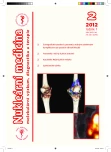Uncertain Lung Nodule
Authors:
Ladislav Zadražil () 1,2; Petr Libus () 1; Marie Burešová () 3
Authors‘ workplace:
Oddělení nukleární medicíny, Nemocnice Havlíčkův Brod, p. o.
1; Radiodiagnostické oddělení, Nemocnice Havlíčkův Brod, p. o.
2; Plicní ordinace, s. r. o., Nádražní 582, Havlíčkův Brod
3
Published in:
NuklMed 2012;1:30-33
Category:
Casuistry
Overview
The benefit of SPECT/CT with the application of the In111-DTPA-octreotide (Octreoscan) and the benefit of the F18-FDG-PET/CT examination in the assessment of metabolic activity in a solitary lung nodule of a malignant pattern according to the CT scan is presented in this case report. The combination of the CT scan and nuclear medicine examinations made possible to avoid invasive diagnostic methods such as a lung biopsy.
Key words:
solitary pulmonary nodule, Octreoscan, somatostatin receptor scintigraphy, F18-FDG, positron-emission tomography
Sources
1. Gould MK, Maclean CC, Kuschner WG, Rydzak CE, Owens DK. Accurancy of Positron Emission Tomography for Diagnosis of Pulmonary Nodules and Mass Lesions: A Meta-analysis. JAMA 2001; 285 (7): 914–924
2. Táborská K. Somatostatinová receptorová scintigrafie 99mTc-EDDA/HYNIC-TOC: První klinické zkušenosti v České republice. Nukleární medicína 2012; 1 (1): 7–12
3. Kirsch CM, Pawel J, Grau I, Tatsch K. Indium-111 pentetreotide in the diagnostic work-up of patients with bronchogenic carcinoma. EJNM 1994; 21 (12): 1318–1325
4. Louthan O. Neuroendokrinní nádory: Klinické pohledy, Praha: Grada, 2005; 344
Labels
Nuclear medicine Radiodiagnostics RadiotherapyArticle was published in
Nuclear Medicine

2012 Issue 2
Most read in this issue
- Uncertain Lung Nodule
- Remarks to and drawings of lung anatomy
- Scintigraphy in patients with possible inflammation after joint replacement with prosthesis
- Incidental discovery of renal carcinoma based on liver visualization during Tc-99m MAA lung scan
